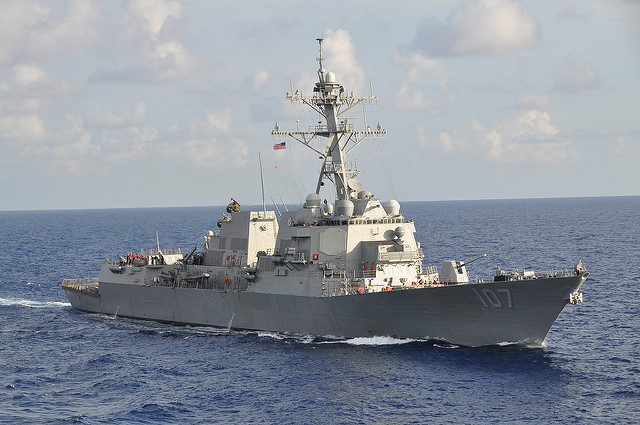
On 28 June, the Russian Ministry of Defense released a statement, and a video, accusing the US Navy and the destroyer USS Gravely of unsafe and unprofessional maneuvering while overtaking the Russian Navy frigate Yaroslav Mudry in the eastern Mediterranean on June 17. As a naval officer, my own reaction upon viewing the video, was that this was not as serious a situation as the Russian MoD described. A colleague, a former commanding officer of a destroyer and a cruiser described it as “No danger, but I would be [angry] if someone did that to me.”
And then more details of the story emerged. Counter to the Russian claims, a Pentagon handout recounted the U.S. Navy version of events. Over an extended period of over an hour, the Russian frigate, displaying international symbols indicating a restricted ability to maneuver, repeatedly maneuvered to match the course and speed of the US Navy destroyer. The Yaroslav Mudry appeared to take a heading to the US aircraft carrier Harry S Truman, interpreted to be “intentionally trying to interfere with Harry S Truman Operations” according to a U.S. European Command spokesman.
We should have expected this. Even before the well-publicized incident in the Baltic Sea – of Russian Su-24 Fencer fighter jets and a Ka-27 Helix operating in an unsafe and unprofessional manner in repeated flybys of the USN DDG USS Donald Cook – Russian statements have depicted US operations as aggressive, and Russian interactions as a defensive response to threatening, increased NATO and US operations in the waters and airspace of the Baltic and Black Seas.
However, this was in neither the Baltic nor the Black Sea – the eastern Mediterranean is 600 miles as the crow flies from any Russian coastline. The Russian Navy was interfering with US Navy aircraft carrier operations that were in no way a threat to Russia’s homeland. So why did they do that? The Truman’s eastern Mediterranean operations include airstrikes in support of the coalition campaign against ISIL in Syria. These counter-ISIL operations, despite being part of a broad-based coalition, are at odds with Russia’s geopolitical objectives in the region – supporting the Assad regime in the ongoing civil conflict. Russia’s commitment to these objectives has been demonstrated by a sizable deployment to Syria and ongoing operations which have included airstrikes against U.S.- and allied-supported insurgent groups which oppose the Russian proxy in Damascus.
We should not be surprised to see similar incidents in the future in the High North, the Baltic Sea, and the Black Sea, as well as far from Russian shores – in the eastern Mediterranean, in the north Atlantic, in the Indian Ocean, and in the Pacific. Since the 2014 Crimea annexation, Putin has grown more willing to use military power to assert Russia’s great power status in the Russian periphery and further abroad, and the fruits of the 2020 State Rearmament Program provide increasingly effective tools to do so. The maritime domain will continue to see these risky interactions between US and NATO air and naval forces and Russia –international waters and air space provide a ready stage where the transatlantic ideals of a global commons and the international rules-based order conflict with Russia’s willingness to disregard or rewrite those rules to ensure the Kremlin’s ability to operate in support of Moscow’s goals.
The transatlantic community – the US and NATO – must respond with steady strength in defense of the international rules-based order. NATO must commit to keeping up its naval capabilities, must continue to assert the rights of freedom of navigation in the global commons, and must maintain a robust presence in the High North, the Baltic, and the Black Sea so as not to cede any of these international spaces to be a “Russian lake.”
However, this incident also highlights an area where Russia has consistently achieved tactical successes: the information domain. The Kremlin frequently moves more quickly than Western officials in the effort to maintain dominance of the narrative. We are already operating at a disadvantage, beholden as we are to the truth. In this case, Russia’s version of the narrative was out early, with video, while the US response falls into the area of “if you’re explaining, you’re losing.” While the video of “dangerously close” US maneuvering elicited little response from naval professionals, many laymen probably took the Russian assertions at face value. This was clearly a response to the US release of video of the April incident of a close – and undeniably unsafe and unprofessional – flyby of the USS Donald Cook. But that April US release was a rare example of a Western success in the information domain.
In addition to showing presence and strength in the maritime domain, the US and NATO must remain vigilant in the international information space to ensure the continued success of the international rules-based order which continues to benefit the entire world.
Captain Steven Horrell is the U.S. Navy Senior Fellow at the Brent Scowcroft Center on International Security, the Atlantic Council. Opinions expressed are his own and do not reflect the views of the U.S. Navy or the Department of Defense
Image: USS Gravely, Sept. 27, 2012 (photo: Lt. Cmdr. Corey Barker/US Navy)

